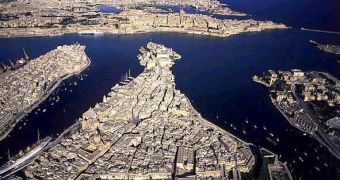In the neuralgic center of the Mediterranean, there's a small country of only 315 square km, independent since 1964, which maintains its own identity despite the massive affluence of tourists from all over Europe which arrive on its untamed and sunny beaches every season of every year. Its agricultural and fishing villages contrast with the imposing setting of the luxurious hotels that break its Mediterranean aesthetics.
Malta comprises three islands (Malta, Gozo and Comino) and some uninhabited islets, like Cominnotto and Filfla. The traveler meets here two realities: the historical one with its churches and fortresses, and the 'entertainment' one, with beaches, tourists looking for relaxation at low prices and feel little or none attraction towards the Maltese culture.
But Malta is turning into a destination which combines cultural attractions with sun and nautical sports. But this site does not require beaches and blue waters to justify a journey. Its history, culture, people and traditions are enough.
Megalithic temples prove Malta was habited since the Stone Age. Along the history here passed Phoenicians, Carthaginians, Romans, Byzantines and Arabs, but the lasting influence was left by the Order of Knights of the Hospital of St John. These Christian soldiers started by caring for the wounded and diseased soldiers during the Crusades, but soon started the fight against the unfaithful and later to be guarantors for the pilgrims towards the Holly Land. After being expelled from the Jerusalem by the Turks in 1291 and from Rhodes, where they acted like a shield against Islam, the Emperor Charles V allowed them to install in Malta, in change for the symbolic annual rent of a falcon.
They found themselves on a poor island, where the goats grazed over a wild territory and rabbits were devastating any blade of matorral. Soon, they started to build hospitals, churches, and especially, fortresses, as the islands were in the middle of the conflicts of the Mediterranean.
In 1565, the Knights were besieged for a month by the Turkish sultan Suleiman the Magnificent and once again they shut the door of Europe in front of the Turks. The Maltese capital La Valletta is said to have emerged after the Turkish besiege, when John de la Valletta, the grand master, decided to build a small fortress in the small peninsula where the San Elmo fortress was found. Structured in quadrangular blocks, with a magnificent draining system, La Valletta is nowadays exactly as it used to be 400 years ago.
Other fortress cities are Victtoriso, Senglea and Cospicua, which, despite forming just one city, are still considered "The Three Cities". There are many chapels filled with tombs of the grand masters, all with lavish marble tombstones.
Today, 98 % of the Maltese consider themselves Practicing Catholics, but there's a very curious detail: the Maltese language is derived from Arab, due to the Arab occupation, from 870 to 1091.
The Maltese Cross, symbol of the Order of Knights of St John is present everywhere, from shop windows to various jewel stores.
But the red phone cabins "Made in England" represent another historical period, of 150 years, of British domination which left deep marks. Most of the Maltese people have a perfect English.
The islands are caressed by breezes from North Africa or European winds, depending on the day and season.
Despite overpopulation and the rocky, arid terrain, Malta counts with large extensions of land gained from the mountain slopes, with terraces dedicated to the culture of Mediterranean crops.
The legend says that in the island of Gozo, the nymph Calypso captivated Ulysses (Odysseus), the Greek Trojan hero, with her charms for months, in a cave located in one of the most attractive beaches of the island, Ramla.
Also on this island, Saint Paul shipwrecked and remained for quite a long time, so that there is a route following his steps on the island.
Malta always received travelers, navigators, and even whole armies. The last one in reaching the islands, before the great tourist avalanche, was that of the Allied Troops during the Second World War. The archipelago turned into an important naval base over which devastating bombs fell daily. At the end of the war, the Maltese people received The Saint George Cross, the highest British decoration conceived for the civilians.
Even if today Malta is one of the most Catholic countries in the world, there is an old tradition in Malta, dating from the times of the Arabs: the "Eye of Allah" painted on both sides of the prow on the fishing boats.

 14 DAY TRIAL //
14 DAY TRIAL //